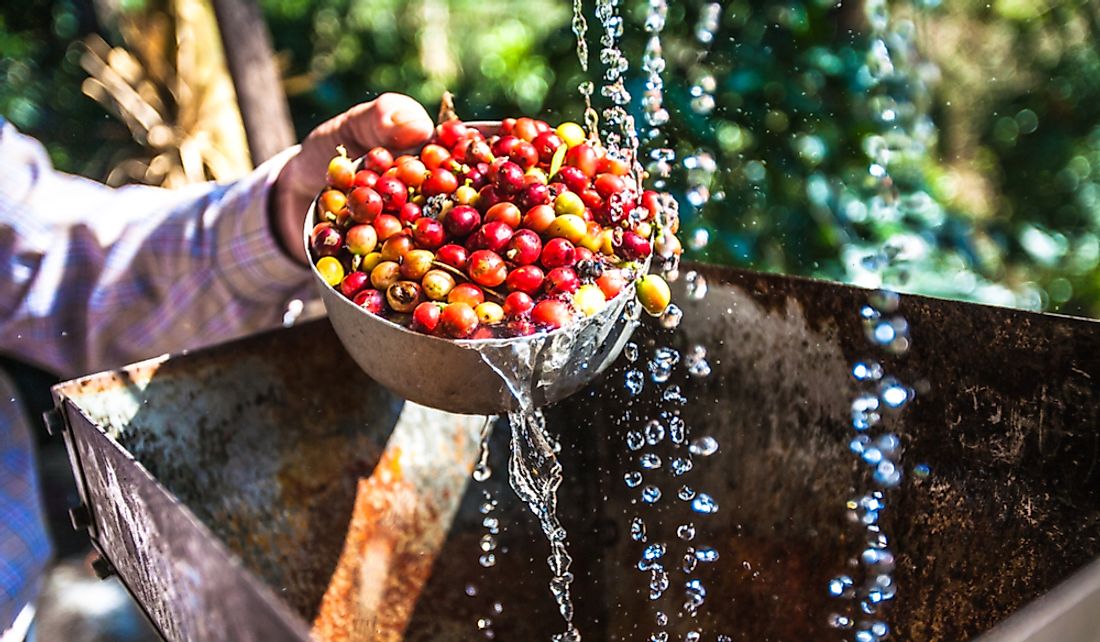What Is Coffee Wastewater?

Coffee is consumed in various forms but most popularly as a drink. However, before it gets to the table, the raw coffee has to be processed and refined into a usable form. Coffee processing involves de-pulping of the cherries, fermenting the coffee beans, and grinding of the beans. Water is an important component of coffee processing and is used in almost all the processing stages. The type of processing determines the amount of water used. Fully washed coffee processing requires a lot of water compared to the dry processing. The water that has been used in the coffee processing unit contains a high level of pollution and is often referred to as coffee effluent or coffee wastewater.
Coffee Processing
The coffee cherries undergo several processes to make it fit for consumption. The process involves the use of a large quantity of water, leading to the production of large amounts of liquid and solid wastes. The type and amount of waste depend on the method of processing coffee cherries. Turning cherries into dried coffee beans can be made possible through either of the three processes; dry, fully washed, or semi-washed processes.
Drying
Once the coffee cherries have been harvested from the farm, the cherries are dried through sun drying or artificially. Sun drying involves placing the coffee cherries on a flat surface and left to dry while artificial drying is mainly used during wet seasons when there is no sufficient sunlight. The dried cherries are then hulled to remove the outer layer known as pericarp.
Semi-Washing
The coffee cherries can also be semi-washed to remove the pericarps, after which the mucilage layer is removed. The removal of mucilage is mainly done through the process of fermentation which takes 14 to 18 hours. Fermentation helps to degrade the mucilage, making it easy to be removed with water. The resulting water is highly concentrated with mucilage and other impurities and is highly viscous. The byproducts are commonly used as a worm substrate to make natural fertilizer. Semi-washing is generally used in Brazil and Mexico and uses between 3-4 m³ of water per tonne of fresh coffee cherries.
Full Washing
Coffee cherries can also be processed by full washing. The method is mainly applied when processing coffee Arabica. After the cherries are de-pulped, the beans are put in a fermentation tank where mucilage is removed using bacteria. The fermentation phase takes 12-36 hours and also assist in the development of flavor. Once fermentation is completed, the beans are thoroughly washed to remove any remaining mucilage and residue. The beans are then rapidly dried. Full washing is generally used in Kenya, Colombia, and Vietnam and can use up to 20 m³ of water per tonne of fresh coffee cherries.
Water Reuse
The type of processing greatly impacts the amount of water used. Semi-washing versus full washing uses vastly less water. In India, full washing uses 14 to 17 m³ of water per tonne of fresh coffee cherries whereas semi-washing with wet processing uses 3 m³ of water per tonne of fresh coffee cherries. However, improved washing techniques and reuse of water can reduce the water used from up to 20 m³ of water per tonne of fresh coffee cherries to as low as 1 m³ of water per tonne of fresh coffee cherries. For example, in Nicaragua, reuse of water lowered the water usage from 16 m³ of water per tonne of fresh coffee cherries to 11 m³ of water per tonne of fresh coffee cherries.
Impacts of Coffee Production
Coffee wastewater is one of the byproducts of coffee processing. This water contains a high level of pollution with organic matter as the main component. The organic matter stems from the de-pulping process and mucilage removal. Water used in de-pulping of cherries is called pulping water and is the largest amount of water used in coffee processing, accounting for over half of the water used. The coffee wastewater also contains flavonoid compound which comes from the skin of the cherries. This compound is responsible for the dark coloration of the water and the higher PH (at least 7). When not directed to a treatment system, coffee wastewater can be detrimental to aquatic life.











